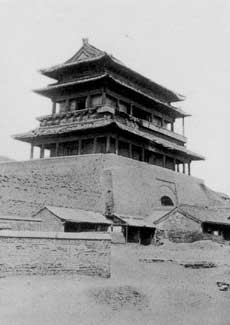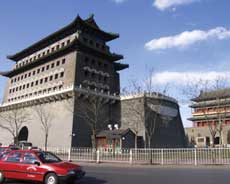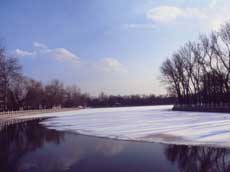| Protecting the Old Capital |
| http://www.sina.com.cn 2005/04/11 18:29 thats China |
Persisting Efforts The Beijing municipality has been paying great attention to the protection of the city's appearance and its cultural legacy. In July 2000, the Beijing municipal government allocated a total of 330 million yuan to renovate ancient buildings over the next three years. This is the largest sum that Beijing has invested in the protection of historical sites since 1949. In November of the same year, swathes of courtyards, including those in the Shichahai, Dazhalan, Guozijian and Nanchizi areas, were included in 25 protected zones established by the municipal government. In 2002, another 15 protected zones were added. Also in 2002, guidelines were developed stipulating that the Old City should be protected as a whole and restricting the scale and height of new buildings in the Old City, especially along the north-south axis. In 2003, 658 courtyards were placed under protection, an urgent move and a direct response to the demolition of large numbers of valuable courtyards outside of the protected zones. In another effort launched in April 2004, the city published a new policy encouraging individuals and organizations to purchase Beijing's courtyards.
However, the districts of the Old City have yet to find a way to effectively improve the living conditions in the hutongs while also preserving the old courtyard homes. "It is a complicated question involving different interests," and anonymous official discloses. "Unlike the Chaoyang and Haidian Districts, the governments of the four districts in the Old City don't have more real estate to develop their economies, so they have to create new buildings on the relics of the old. In addition, they also want to solve practical problems for their residents and improve their living conditions, but they don't have much money. So they turn to real estate developers. These businessmen want to pursue the largest practical interests, and in their eyes, the valuable ancient constructions are only piles of shabby bricks and tiles. As for some residents, they never feel satisfied with the compensation they receive from the government or real estate developers to help them renovate or relocate." Fortunately, scholars and experts in related fields are discussing a win-win way to protect the old capital's appearance through a program of old home renovation. In January 2005, the State Council approved a new city plan for Beijing, directing the city's role through 2020 as both an ancient capital and an international metropolis. The plan clearly underlines the protection and preservation of Beijing's historical and cultural legacy. Most importantly, the city plans to change the current "one center" layout to a "multi-center" one, easing the focus on the Old City as several more city centers with different functions are constructed. This is similar to Tokyo, which is composed of a number of city centers and lacks a real "downtown" area. Some insiders believe that a number of government offices might move out of the Old City in order to attract various investors and alleviate problems in the traditional city center brought on by traffic and limited resources. Wang Jun regards these developments as a big step that could "halt the demolition of the Old City."
Standing on the top of Jingshan (the highest point of the Old City when it was built), Beijing's central axis is very clear, running between the Yongdingmen Gate on the south end and the Drum and Bell Towers on the north end. Now, the central axis, the symbol of Beijing as an ancient capital, is extended north to the Olympic Park, the heart of the 2008 Olympic Games. Hutong and Siheyuan The word "hutong," means "water well," in Mongolian. The Mongolians keep the nomadic tradition of settling down around springs or wells. A hutong is the passage formed by lines of siheyuan (four-side enclosed courtyards). Strictly, hutong alleys are less than nine meters wide. Most hutongs in Beijing run in an east-west or north-south direction, with most houses facing south to take in as much sunshine as possible. A standard siheyuan usually consists of houses on its four sides with a yard in the center. The gates are usually painted red and have large copper door rings. Usually, a whole family lives in compound. The elder generation lives in the main house standing at the north end, the younger generations live in the side houses, and the south house is usually the family sitting room or study. Hutong joins hutong, and siheyuan meets siheyuan to form a block. Blocks join with blocks to form the whole residential constructions.
|
|
|
|
|
|
| Annotation |
| 新 闻 查 询 |
| 热 点 专 题 | ||||
| ||||
|
教育频道意见反馈留言板 电话:010-82628888-5747 欢迎批评指正
新浪简介 | About Sina | 广告服务 | 联系我们 | 招聘信息 | 网站律师 | SINA English | 会员注册 | 产品答疑
Copyright © 1996 - 2005 SINA Inc. All Rights Reserved
版权所有 新浪网![]() 北京市通信公司提供网络带宽
北京市通信公司提供网络带宽


